Sagamore Beach Weather Insights for Kiteboarding
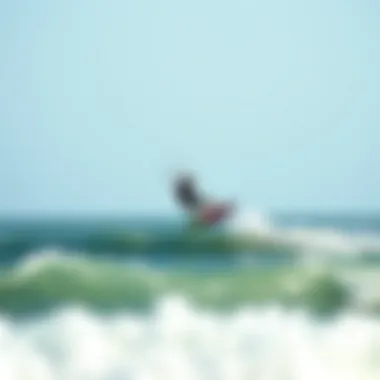
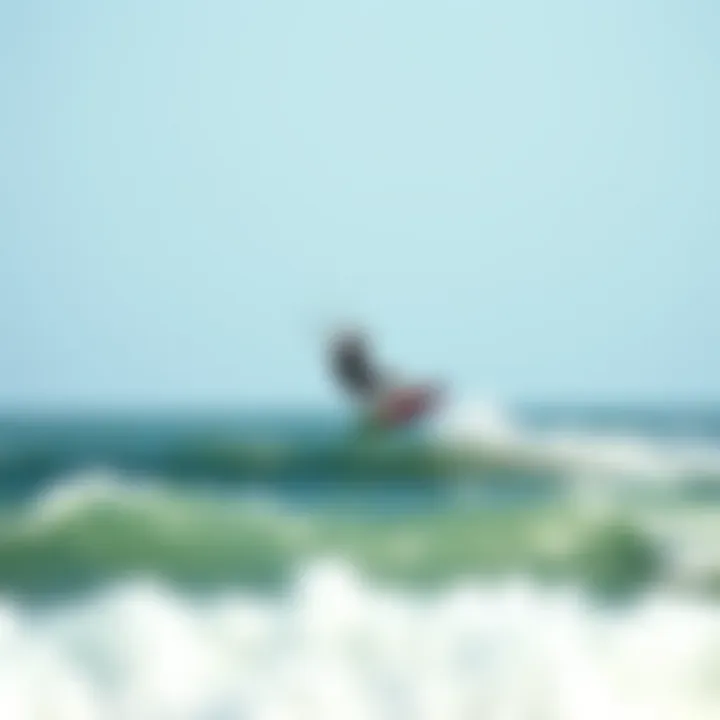
Intro
Kiteboarding at Sagamore Beach offers a thrilling experience for both newcomers and seasoned riders alike. The unique weather patterns prevalent in this region directly influence kiteboarding conditions. Understanding these environmental factors can be the difference between a fun day on the water or a frustrating one. This guide aims to help kiteboarding enthusiasts navigate the complexities of Sagamore Beach's weather by diving into critical elements like wind speed, ocean currents, and seasonal variations. With the right knowledge, you can enhance your kiteboarding adventures, ensuring both safety and performance.
Gear Selection
Choosing the right gear is crucial for an enjoyable kiteboarding experience. The right kite and board can significantly impact your performance, especially considering the ever-changing conditions of Sagamore Beach.
Types of Kites
There are several types of kites suitable for different conditions, including:
- C-Kites: Known for their high performance and power, perfect for experienced riders in strong winds.
- Delta Kites: Versatile in various wind conditions and forgiving for newcomers.
- Bow Kites: Excellent for light wind and provide a good range.
When selecting a kite, consider the wind conditions you’ll encounter at Sagamore Beach. During summer, winds are generally lighter, making a bow or delta kite ideal. In contrast, fall often brings stronger winds, where a C-kite may serve you better.
Choosing the Right Board
Board selection is equally important. Factors like your skill level, weight, and the type of conditions you'll be riding in come into play:
- Twin-tip Boards: Great for all-around use and easy to ride.
- Surfboards: Best when waves are present, they provide stability and maneuverability.
A good rule of thumb is to choose a board that complements your kite type and matches the conditions you're expecting to face.
Skill Development
To truly make the most of Sagamore Beach's kiteboarding opportunities, skill development becomes essential. Whether you're just starting or looking to refine your technique, understanding the following aspects will be advantageous.
Essential Techniques
Mastering the fundamentals will elevate your kiteboarding experience:
- Body Dragging: An essential skill for retrieving your board in water.
- Water Starts: Learn the correct technique to get on your board smoothly.
Additionally, keep an eye on the wind direction and currents, as they can significantly impact your maneuvers.
Progression Tips
For those looking to advance their skills, consider the following tips:
- Practice Regularly: Consistency is key. Frequent practice helps solidify skills.
- Join a Local Community: Engaging with a group of kiteboarders allows for shared experiences and tips.
Incorporating local knowledge about Sagamore Beach's weather patterns can further help you pick the best times to hit the water.
“The right gear and skills can turn the tide in your favor. Invest time in learning your environment.”
By equipping yourself with up-to-date information and techniques tailored for the beach's unpredictable weather, you can set sail towards more enjoyable and safe kiteboarding experiences.
For more information about kiteboarding and weather conditions, check out these resources:
Understanding the subtleties of Sagamore Beach weather is key; with each breeze and wave, there exists an opportunity to elevate your kiteboarding game.
Prolusion to Sagamore Beach Weather
When it comes to kiteboarding, understanding the local weather is absolutely crucial. For enthusiasts who frequent Sagamore Beach, having insight into the distinct weather patterns enables kiteboarders to harness the right conditions for their sport. More than just a whim, kiteboarding relies heavily on a blend of wind, temperature, and ocean conditions. This section serves as a vital introduction to those aspects, laying the groundwork for a thorough examination of the area's climate.
Geographical Context
Located on the scenic Cape Cod Canal, Sagamore Beach enjoys a unique geographical position that significantly influences its weather. This coastal area is bordered by sandy beaches, marshes, and access to the Atlantic Ocean. The proximity to large bodies of water generally leads to milder temperatures and variable winds, which are critical for kiteboarding activities.
The beach's surroundings also play a role in dictating how weather patterns behave. For instance, the salt marshes nearby can affect humidity levels, and the orientation of the beach can determine the direction of incoming winds. Moreover, local topography might create microclimates that are worth noting. Understanding such geographical nuances can dramatically impact kiteboarding decisions.
Significance for Kiteboarding


For kiteboarders, the importance of weather cannot be overstated. Wind patterns dictate not only the feasibility but also the enjoyment of the sport. For instance, an understanding of prevailing winds and seasonal changes can help athletes select the most suitable times to hit the water. Now, let’s break this down:
- Wind Conditions: Knowledge of local wind patterns equips riders with the ability to predict which days will yield optimal conditions for flying their kites.
- Temperature Considerations: Temperatures also enter the equation when selecting equipment and clothing. Rider comfort is essential to enjoying the sport and performing well.
- Safety Factors: Being aware of adverse weather conditions—like sudden storms or high winds—can make all the difference in avoiding hazardous situations during kiteboarding.
In summary, having a strong grasp of the weather in Sagamore Beach is more than just a nicety; it's essential for making informed decisions that enhance the kiteboarding experience. A well-rounded understanding of geographical features and their implications allows riders to strategize their outings effectively, prioritize safety, and maximize fun.
The Climate of Sagamore Beach
Understanding the climate at Sagamore Beach is pivotal for kiteboarding enthusiasts as it lays the foundation for an enjoyable and successful experience on the water. The interplay of seasonal transitions, temperature fluctuations, and prevailing winds directly influences the conditions one may encounter while kiteboarding. By deciphering this climate puzzle, riders can not just select the right day for their adventure, but also enhance their skills, optimize performance, and ensure safety.
Overview of Seasonal Changes
Sagamore Beach experiences a distinct four-season climate, which affects kiteboarding opportunities significantly.
- Spring (March to May): As temperatures rise and the chill of winter recedes, this season offers mild conditions perfect for adventurous riders. The winds begin to pick up speed, which can be exciting for kiteboarders eager to get back in action. However, it’s essential to keep an eye out for shifting weather patterns, as spring can be unpredictable.
- Summer (June to August): Summer brings warmer temperatures, often ranging from the upper sixties to mid-eighties Fahrenheit. The increased heat draws more kiteboarding enthusiasts to the beach. It’s also the peak time for favorable wind conditions, making long days fun for both beginners and pros. That said, daily humidity and sudden summer storms can serve as a reminder for kiteboarders to stay vigilant.
- Fall (September to November): Fall often features a dramatic shift in weather with cooler temperatures arriving as summer wanes. Kiteboarding during this time can be idyllic, with consistent winds and fewer crowds on the water. The beauty of the changing foliage adds another layer of joy to the sport.
- Winter (December to February): The winter months test the resolve of even the most seasoned kiteboarders. With temperatures dipping into the thirties and forties, kiteboarding becomes more of a challenge. Nonetheless, some riders dare the colder waters, seeking out crisp breezes and the tranquility that winter brings.
Temperature Ranges Throughout the Year
Temperature plays a significant role in the overall kiteboarding experience at Sagamore Beach. Being aware of what to expect month-to-month can help riders prepare appropriately.
- Winter Temperatures: December through February typically sees highs around 40–50°F (4–10°C). Layering gear becomes crucial for those daring enough to venture out during these months, as exposure to the cold can quickly dampen spirits.
- Spring Temperatures: From March to May, temperatures gradually rise, averaging highs of 50–70°F (10–21°C). Spring is ideal for those who enjoy cool air while still catching a breeze on the water.
- Summer Temperatures: Summer boasts the warmest weather, with highs often reaching the 70s to mid-80s°F (21–30°C). The warm air creates a more inviting atmosphere for riders, but it's essential to bring hydration and sun protection when spending long hours outdoors.
- Fall Temperatures: In September through November, kiteboarders can look forward to mild weather with highs in the 60s and low 70s°F (15–24°C). It’s an excellent time for those who enjoy a gentle, cooling breeze while gliding across the waves.
Understanding these temperature ranges not only helps kiteboarders to choose the right attire but also to prepare their gear accordingly.
By staying attuned to the climate shifts and temperature trends at Sagamore Beach, enthusiasts can enhance their kiteboarding experiences while ensuring a safe and enjoyable time in the water. Before heading out, always check the forecast to make sure you are adequately prepared for the day’s conditions.
Wind Patterns: A Key Element for Kiteboarding
When it comes to kiteboarding, the wind plays a role akin to that of a maestro conducting a symphony. It’s not just there; it shapes the entire experience from takeoff to landing. If you’re serious about catching the best waves at Sagamore Beach, understanding wind patterns is a necessity, not a luxury. Let’s break down some of the essential components.
Understanding Wind Direction
Wind direction serves as a compass for kiteboarders, guiding choices about where to launch and land. In Sagamore Beach, winds primarily come from the southwest or northwest, influenced by coastal topography and the surrounding landscape.
- Southwest Winds: These typically bring warmer air, enhancing not just kiteboarding conditions but also your overall experience. Riders often find themselves with better lift and dynamic control when the winds come from this direction.
- Northwest Winds: While slightly chillier, these winds can deliver reliable gusts for more expert riders.
Understanding how these winds interact with the beach is crucial. For instance, if you are launching from the east side of the beach, a southwest wind may produce better conditions compared to a northwest one, which may cause slightly choppy water.
"Wind direction can make or break your kiteboarding day. Understanding where it comes from will really shape your ride."
Wind Speed Varieties by Month
The speed of the wind varies significantly throughout the year, and being aware of this can influence when you choose to hit the water. Here’s a closer look at the wind speed you might expect during each month:
- January - March: Average wind speeds hover around 10-15 knots, making it ideal for beginners.
- April - June: Things pick up, with winds typically ranging from 12-20 knots. This is when you might start seeing more experts around the beach.
- July - September: Peak kiteboarding season, with winds often exceeding 20 knots, making it exhilarating yet demanding.
- October - December: Winds slow down again, averaging 8-12 knots, perfect for those sunny, calm days.
This monthly breakdown can help you anticipate the right time for your kiteboarding adventure. Whether you are a novice in search of gentle breezes or an experienced kiteboarder looking for adrenaline-pumping speeds, knowing the monthly wind patterns lets you plan better.
Optimal Wind Conditions for Riders
Ideal wind conditions involve not just speed but also consistency. Knowing the sweet spot can make your kiteboarding session fulfilling. Here’s what to aim for:
- Wind Speed: A steady 15-25 knots is often regarded as the sweet spot for most riders.
- Wind Consistency: Look for days where the wind doesn’t shift drastically. Gusty winds can lead to a bumpy ride.
- Conditions at the Beach: For kiteboarding, a cross-shore wind is generally safest. It allows a clear path back to shore while providing necessary lift.
In summary, paying attention to wind patterns isn’t just about checking a weather app. It's about understanding how these elements dynamically interact with each other and the beach's landscape. They’re the unsung heroes of kiteboarding at Sagamore Beach, sculpting the experience for seasoned athletes and newer riders alike.
Navigating these complexities can profoundly influence your kiteboarding experience, ensuring that ultimately, the wind is working with you, not against you.
Ocean Currents and Their Impacts
Understanding ocean currents is vital for kiteboarders at Sagamore Beach. These currents can significantly affect not just the conditions on the water, but also the overall experience for the rider. When kiteboarding, your ability to maneuver safely and effectively hinges on knowing these currents, as they dictate wave patterns, wind interactions, and even safety protocols.
Identifying Local Currents
Local currents at Sagamore Beach are primarily influenced by tidal movements and seasonal weather patterns. Two main currents can generally be observed here:

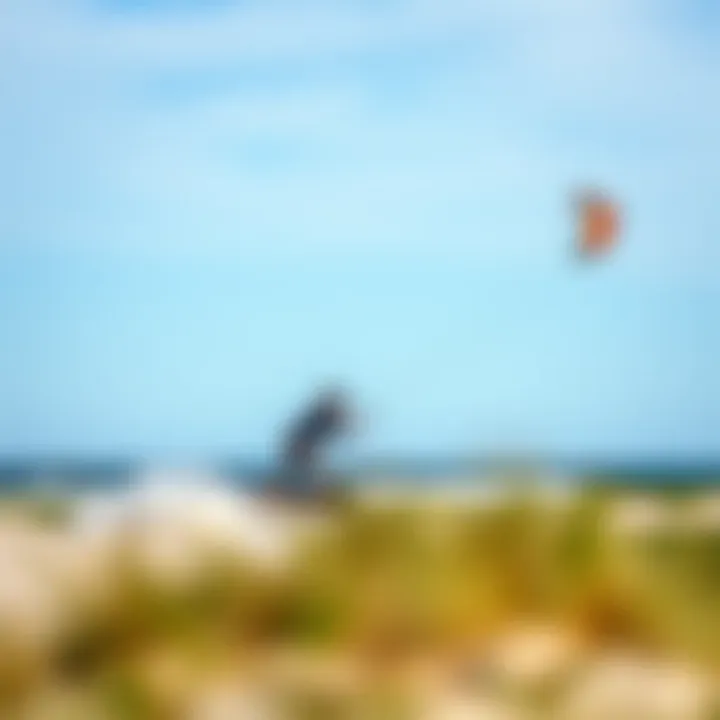
- Inshore Currents: These currents run parallel to the shore and can be gentle but will vary with the tide. They can lead to sudden shifts in water flow, so it's essential for kiteboarders to be aware of them.
- Offshore Currents: These movements often push water away from the beach towards deeper areas. Understanding when these currents are strongest can help kiteboarders determine the safest time to go out on the water.
To gauge local currents effectively, kiteboarders are advised to observe:
- Tides: Check tide charts regularly. High tides can change currents significantly, altering both water depth and flow.
- Current Indicators: Look for visual cues such as foam or debris floating in the water. These often signal nearby currents.
Effects on Kiteboarding Conditions
Ocean currents play a crucial role in shaping kiteboarding conditions at Sagamore Beach. Here’s how they impact your kiteboarding experience:
- Wave Conditions: Strong currents can modify wave heights. For instance, if an outgoing current meets a strong wind, it can create choppy waters that are less than ideal for steady riding.
- Safety Concerns: A too-strong current can pose risks, like pulling an inexperienced kiteboarder further from the shore or complicating landing conditions. Keeping abreast of current forecasts is vital.
- Launch and Landing Zones: The direction and strength of a current can dictate the best spots for launch and landing. Some areas may look inviting but could have hidden strong currents, making them potentially hazardous.
Always assess current conditions before setting out. A solid understanding of how local currents operate will lead to a safer and more enjoyable kiteboarding experience.
Organic navigation is sometimes better than relying solely on technology. Talk to locals and observe how conditions change throughout the day. Access to local insight can be invaluable in honing your skills and understanding the dynamics of Sagamore Beach’s ocean currents.
By becoming acquainted with these essential elements, kiteboarders can ensure they are well-informed and prepared for whatever conditions their kiteboarding excursion may entail.
Adverse Weather Conditions: What to Watch For
Understanding adverse weather conditions is essential for kiteboarders looking to enjoy Sagamore Beach safely and effectively. From stormy skies to sudden fog, the weather can shift faster than a kite catches the breeze, making it vital for riders to stay informed. Here, we will explore the significant elements of adverse weather, the risks they pose, and what kiteboarders should be on the lookout for before setting sail.
Storm Patterns and Their Risks
Storm patterns are a kiteboarder's worst nightmare, capable of transforming a perfect day into a dangerous predicament. The Atlantic hurricane season, peaking between June and November, introduces the threat of tropical storms and hurricanes to Sagamore Beach. These storms generate powerful winds and deadly waves, creating hazardous kiteboarding conditions. Riders should pay attention to weather forecasts, especially when the skies begin to turn dark.
To identify potential storms:
- Check Local Forecasts Regularly: Websites like weather.gov and apps such as Windy provide real-time updates on storm formation.
- Watch for Hints of Shift: When the wind suddenly drops or changes direction, this can be a precursor to storm activity.
Getting caught in a storm not only risks injury but can also damage equipment. Always err on the side of caution and delay your session if there's even a hint of a storm brewing.
Fog and Reduced Visibility
Fog can creep in without much warning, shrouding the beach and reducing visibility to almost nothing. For kiteboarders, this poses a significant danger, as navigating the waters under these conditions can become nearly impossible. Fog often forms in the early morning or late evening and may linger even longer near the coastline.
To combat fog:
- Utilize GPS Devices: Trusty GPS devices can help keep you oriented should fog roll in.
- Stick to Familiar Areas: Avoid venturing into unfamiliar waters where navigation becomes tricky while visibility is low.
If fog seems to be moving in, it’s wise to postpone your session. Remember, it’s far better to skip a session than risk your safety.
Cold Fronts and Their Effects
Cold fronts can hit Sagamore Beach, bringing with them a notable drop in temperature and shifts in wind patterns. These changes can spell trouble for kiteboarders who are unprepared. A cold front can lead to gusty winds, making kite handling challenging, especially for those newer to the sport. Furthermore, the temperature dip can significantly affect physical comfort and performance.
When a cold front is approaching:
- Monitor Temperature Changes: Noticing a sudden temperature drop? It’s likely a cold front is nearby. Adjust your gear accordingly with layers to keep warm.
- Be Aware of Winds: As the front passes, you might experience a sudden increase in wind speed, often switching from a steady breeze to gusts. It’s critical to assess whether your kite can handle these conditions.
In summary, keeping a keen eye on the weather and knowing what signs to look for can aid kiteboarders. Always be prepared for sudden changes and prioritize safety above all. Remember, while the thrill of kiteboarding can tempt even the most cautious, awareness of adverse weather conditions is key to ensuring a safe and enjoyable experience at Sagamore Beach.
Best Times for Kiteboarding at Sagamore Beach
Understanding the best times for kiteboarding at Sagamore Beach is crucial for anyone looking to make the most of their time on the water. Kiteboarding relies heavily on wind conditions, seasonal changes, and local weather phenomena. This section breaks down these elements, providing aspiring kiteboarders with vital information they can use to plan their outings effectively.
With the right timing, you can maximize your sessions, optimize your skills, and enhance your overall experience on the water. Kiteboarding during ideal conditions not only elevates the thrill but also contributes significantly to safety by reducing the risk of encounters with adverse weather. When the stars align – favorable wind patterns, temperatures, and tides – it's an exhilarating experience that can be both enjoyable and highly productive.
Seasonal Breakdown of Ideal Conditions
At Sagamore Beach, each season brings its own unique set of wind and weather characteristics favorable for kiteboarding.
- Spring (March to May): As the chill of winter fades, spring becomes increasingly inviting for kiteboarders. Winds begin to pick up, especially in April and May, with speeds ranging from 10 to 20 knots. The ocean temperature slowly rises, hovering around 50°F to 60°F, making for refreshing yet manageable conditions. Sprin times are all about rebirth, and so it is with kiteboarding – a beautiful time to see nature in full bloom!
- Summer (June to August): The summer months are often regarded as prime kiteboarding season, boasting consistent winds that typically range from 12 to 25 knots. The warmer water temperatures, ranging from 65°F to 75°F, entice many to spend their days riding the waves. However, be mindful of summer storms that can develop quickly, so it’s wise to keep an eye on the forecasts.
- Fall (September to November): Fall retains much of the summer's warmth but brings in a different flavor. The winds tend to pick up intensity as autumn gets underway, especially in September, offering speeds that might exceed 20 knots. Water temps start to dip, but the trade-off often involves fewer crowds and absolutely stunning sunsets.
- Winter (December to February): While winter may seem like a detour from kiteboarding, there are still opportunities for the adventurous souls. Winds can be strong, often ranging from 15 to 30 knots, while water temperatures hover around 40°F to 50°F. Drysuits and thicker gear are essential during this time, but for those willing to brave the cold, winter kiteboarding offers a challenge that can’t be matched.
Daily Timeframes for Optimal Wind
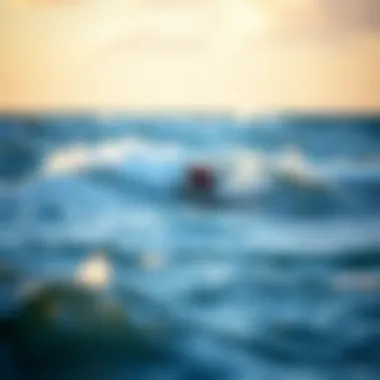
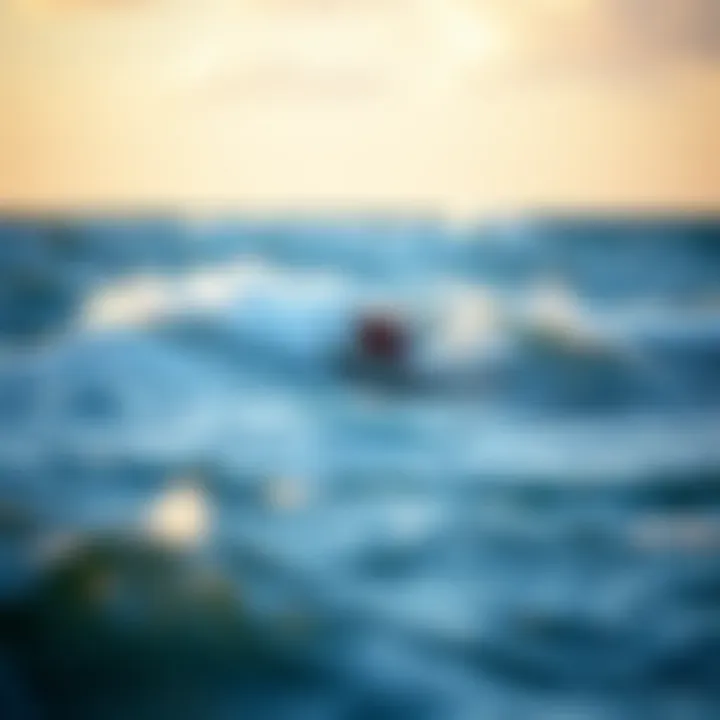
The time of day can also dictate kiteboarding conditions at Sagamore Beach. Generally, kitesurfers should keep the following in mind when planning their day:
- Morning Hours (7 AM to 10 AM): Wind speeds are often lighter during mornings, making it great for beginners wanting to practice without heavy winds. Also, the water tends to be less choppy – a smooth ride!
- Midday (11 AM to 2 PM): Winds usually pick up by mid-morning and can reach their peak midday. This timing is ideal for experienced kiteboarders; the stronger winds offer a more dynamic experience.
- Afternoon (3 PM to 6 PM): In the late afternoon, winds may not be as strong but can still present worthwhile conditions, especially if you're looking to wind down from a day of action. The coast may also begin to see shifting breezes as seabreezes develop.
- Evening (7 PM Onward): As the sun sets, wind patterns can change unpredictably. Often calmer, the evening may still present opportunities for those who enjoy stargazing while gliding over water.
Remember: Always check local conditions before setting out. The wind can shift gear quickly, so don’t rely solely on assumptions. Local weather stations and forecasts can be your best friend's for a successful outing.
With proper planning, kiteboarding at Sagamore Beach can be an exhilarating experience throughout the year. By keeping track of these seasonal and daily patterns, kiteboarders can confidently navigate conditions that will enhance both their performance and enjoyment.
Local Resources for Weather Monitoring
When it comes to kiteboarding at Sagamore Beach, knowledge is akin to power. The weather plays a pivotal role in shaping the kiting experience. Therefore, having robust resources for monitoring weather conditions is imperative for both safety and performance on the water. Keeping a finger on the pulse of local weather through reliable tools can make the difference between a thrilling day on the waves and a regrettable experience marked by unfavorable conditions. This section sheds light on some of the most effective local resources available to kiteboarders.
Using Weather Apps Effectively
In our digital age, weather apps have become indispensable tools for kiteboarders. These applications offer real-time data, forecasts, and alerts at your fingertips. Here are a few points to consider:
- Comprehensive Data: Apps like Windy or Windy.com not only provide wind speed and direction, but also factors such as gust predictions and temperature readings—vital information for assessing kiteboarding conditions.
- User-Friendly Interface: A good weather app should be easy to navigate. Look for features that allow quick access to your favorite spots, with customizable alerts for wind conditions or storms.
- Interactive Maps: Many apps now come with interactive maps that visualize wind patterns and weather systems. This can be an excellent asset for planning out your kiteboarding sessions.
Remember, while technology can guide you, it doesn’t replace the value of experience. Cross-reference app data with local conditions to get a more rounded perspective.
Trusted Local Weather Stations
While mobile apps are handy, local weather stations provide a reliable anchor for accurate weather conditions. Organizations such as the National Oceanic and Atmospheric Administration (NOAA) and local universities often run weather stations that collect data directly from the field. Accessing this information can enhance your kiteboarding readiness. Consider these benefits:
- Accuracy: Local stations typically showcase more precise measurements tailored to specific areas, such as temperature and wind speeds. These can often differ from generalized forecasts.
- Historical Data: Trusted weather stations often provide archive data, allowing riders to analyze previous weather patterns. This becomes valuable when gauging the best times for kiteboarding throughout the year.
- Community Insights: Many local stations have networks of dedicated enthusiasts who share weather updates, providing a human touch to forecasting.
To stay updated, check out resources such as NOAA's National Weather Service or local channels like Cape Cod Weather Network. Engaging with these sources can enhance your kiteboarding venture by aligning your skills with Mother Nature's whims.
Safety Precautions Based on Weather Conditions
Understanding and preparing for weather conditions at Sagamore Beach is crucial for any kiteboarding enthusiast. Adverse weather can turn a thrilling adventure into a dangerous situation in mere moments. By keeping safety at the forefront and preparing for the unexpected, riders can enjoy their time on the water more fully.
Preparing for Sudden Weather Changes
Weather in Sagamore Beach can switch like a light bulb. One moment, the sky is clear, and the next, clouds loom on the horizon. Kiteboarders should always check forecasts ahead of heading out. But it doesn't stop there; real-time updates are key. Many folks recommend using reliable apps such as Windy or NOAA Weather Radar. These tools can provide live information, helping riders stay one step ahead of unpredictable weather changes.
Expect the unexpected, especially during spring and fall. Be alert to signs like sudden wind shifts, darkening skies, or drops in temperature. If you're out there and the weather starts to turn, it becomes essential to have an exit strategy. Know the quickest route back to shore and pay attention to fellow kiteboarders who might be pulling up lines and heading in.
"In kiteboarding, safety doesn’t come second—it’s the first. Always be vigilant, as Mother Nature is unpredictable."
Equipment Adjustments for Varying Conditions
Having the right gear can make or break your kiteboarding experience, especially when conditions vary. Make sure to adjust your equipment depending on the weather. For instance, as winds pick up significantly, it’s best to switch to a smaller kite. Conversely, lighter winds might let you grab that larger kite out of storage.
Also, check your harness and lines; a small tear can result in big trouble, particularly in higher winds. Understanding your equipment's limits is crucial. No two sessions are the same, so if you're familiar with the changes in wind speed and weather conditions, you'll make better choices for your kiting gear.
- Kite Size Adjustments:
- Gear Inspection:
- Choose smaller kites in strong winds (20 mph+).
- Utilize larger kites for light winds (below 10 mph).
- Inspect lines and kites for any wear and tear.
- Ensure your harness fits snugly and is functioning correctly.
By always being prepared and adjusting your equipment accordingly, you'll make sure your kiteboarding adventures remain both fun and safe.
Epilogue and Final Thoughts
Navigating the intricate world of Sagamore Beach weather is an essential step for kiteboarding enthusiasts. Understanding the various weather patterns, scuba diving into wind dynamics, will not only enhance your experience but can also sharpen your skills on the water. Kiteboarding is a sport that dances hand in hand with nature, and for those looking to ride the winds and catch the waves, staying informed about local weather conditions is paramount.
Synthesizing Weather Insights for Best Practices
To summarize, the knowledge gathered throughout this article provides kiteboarders with a clearer vision of how to approach their sessions at Sagamore Beach. Seasonal changes affect not just the wind speeds but also the viability of getting out on the water. Being keenly aware of these elements will allow riders to choose their times wisely and maximize their fun.
- Understand Seasonal Variations: Each season boasts distinct weather patterns. Spring might offer brisk winds, while summer favors warmer, calmer days.
- Monitor Ocean Currents: The flow of water influences not just safety but the overall riding experience. Knowing when and where currents are strongest can help avoid dangerous situations.
- Wind Patterns and Speeds: Recognizing optimal wind speeds for your skill level can make all the difference between a thrilling ride and a hazardous outing.
"Preparation is key. By synthesizing the weather insights, you arm yourself with the tools necessary for success on the water."
Encouraging Responsible Kiteboarding
As we wrap up, it’s vital to underscore the critical role of responsibility in kiteboarding. Enjoying the thrill of the sport comes with a duty to respect the environment and others sharing the space. Keeping an eye on the weather isn’t just about reducing risks for yourself; it also means protecting fellow enthusiasts and the natural surroundings.
- Awareness of Local Regulations: Participate in meetings or community forums to understand specific guidelines set for Sagamore Beach and its kiteboarding scene.
- Eco-Friendly Practices: Take care of the beach, avoid damaging natural habitats, and ensure proper disposal of waste. This preserves the beauty of Sagamore Beach for future generations.
- Stay Informed: Always check weather updates before heading out. Utilize local resources, weather apps, and trusty websites to keep an eye on conditions.
In the end, a kiteboarding adventure successfully melds the thrill of riding the wind with the wisdom of understanding one’s environment. By synthesizing insights and promoting responsible practices, we all can contribute to a safer, more enjoyable kiteboarding culture at Sagamore Beach.















